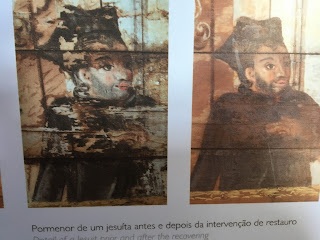The heritage is Portuguese and we were greeted by Baroque with azulejo tilework. Most memorable for me was the Igreja do Colegio in the centre of Funchal. This was built by the Jesuits, who owned vast estates and more or less ran the wine industry until their expulsion in 1760. The church was built 1624-1647 and has been fortunate to have large amouts of restoration accomplished. The attached Jesuit College is now part of the Catholic University. The nave is high and wide - typical of the Jesuits. It is flanked by lateral side chapels with an interconnecting passage in the side walls of the chapels. This was a style from 16th century Portugal and widely used by the Jesuits. The collection of golden carved altarpieces from the 1640s to 1660s is a highlight. The walls of the chapels are covered with tiles produced in Lisbon. High above the nave a trompe l'oeil ceiling has figures gazing down from heaven. The high altar is a masterpiece of 17th century Madeiran woodcarving.It is a very rich Baroque interior - a big contrast to those recently seen in Baden Wuttemberg.
The sacristy is noted for its fine tiles and collection of Flemish painting. In our climb up to the roof we saw a fascination exhibition about resoration work and were also able to peer down into the nave through a spy hole viewing that ceiling from a new angle. This building certainly has atmosphere.
Example of restoration work.
Nore restoration work
Example of the tile work
View of the sacristy
Example of a side altar






No comments:
Post a Comment